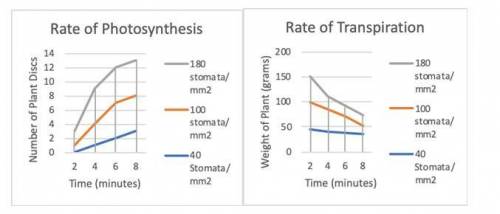
Biology, 06.11.2020 02:50 carolinerosewillis
4. Students testing the effects of stomata count on the rate of transpiration completed a corresponding test on the same plants using the “plant disk” method.
a) Describe the relationship between the rate of transpiration and the rate of photosynthesis visible in the data.
b) Explain why the environmental factors that affect transpiration can also affect photosynthesis.


Answers: 1


Other questions on the subject: Biology

Biology, 22.06.2019 06:30, jadalysrodriguez
Photosynthesis uses co2 and cellular respiration produces co2. we call the point when the two processes are in balance--when there is no net production of co2--the compensation point. how might you limit one of the processes in order to achieve a compensation point?
Answers: 3

Biology, 22.06.2019 11:20, sipstick971
Scientific evidence is most likely to be consistent if it is based on data from
Answers: 2

Biology, 22.06.2019 16:30, mrashrafkotkaat
Monarch butterflies have brightly colored orange wings with black patterns on them, making them easily visible to birds that eat butterflies and moths, yet birds rarely eat the monarchs. likewise, the monarch caterpillars are brightly striped yellow and white and black, and they also are rarely eaten by birds, although some wasps will attack them and feed them to their young. what can be inferred from these observations? monarchs must threaten and attack birds, but not wasps. monarchs have a way of discouraging bird predation that does not involve hiding. monarchs’ wings are so colorful that most birds must find them difficult to eat. monarchs lay more eggs than other less conspicuous butterflies.
Answers: 2

Biology, 22.06.2019 17:30, linshweyioo5442
Ms. w, a 21-year-old woman, came into a clinic after suffering a deep laceration on her foot while walking barefoot around her yard. the wound was cleaned, sutured, and bandaged, and she was released to return home after receiving tetanus antitoxoid. within 72 hours, the wound area was red and swollen, the suture line was dark in color, and it was accompanied by severe throbbing pain. ms. w had a high fever, her heart felt like it was racing, and she was finding it hard to concentraten even on simple tasks. she returned to the clinic and was immediately taken to the hospital. following lab tests, a diagnosis of acute necrotizing fasciitis was made. discussion questions 1. explain why ms. w. received a tetanus antitoxoid before leaving the hospital. (see chapters 3 and 4, infection and passive immunity.) 2. explain how acute necrotizing fasciitis developed in this case and the pathophysiology involved. (see acute necrotizing fasciitis.) 3. what is the potential outcome for ms. w if antibiotic drugs do not reduce the infection quickly?
Answers: 3
You know the right answer?
4. Students testing the effects of stomata count on the rate of transpiration completed a correspond...
Questions in other subjects:


Mathematics, 28.01.2020 03:31


Mathematics, 28.01.2020 03:31



Mathematics, 28.01.2020 03:31

Mathematics, 28.01.2020 03:31

Mathematics, 28.01.2020 03:31



